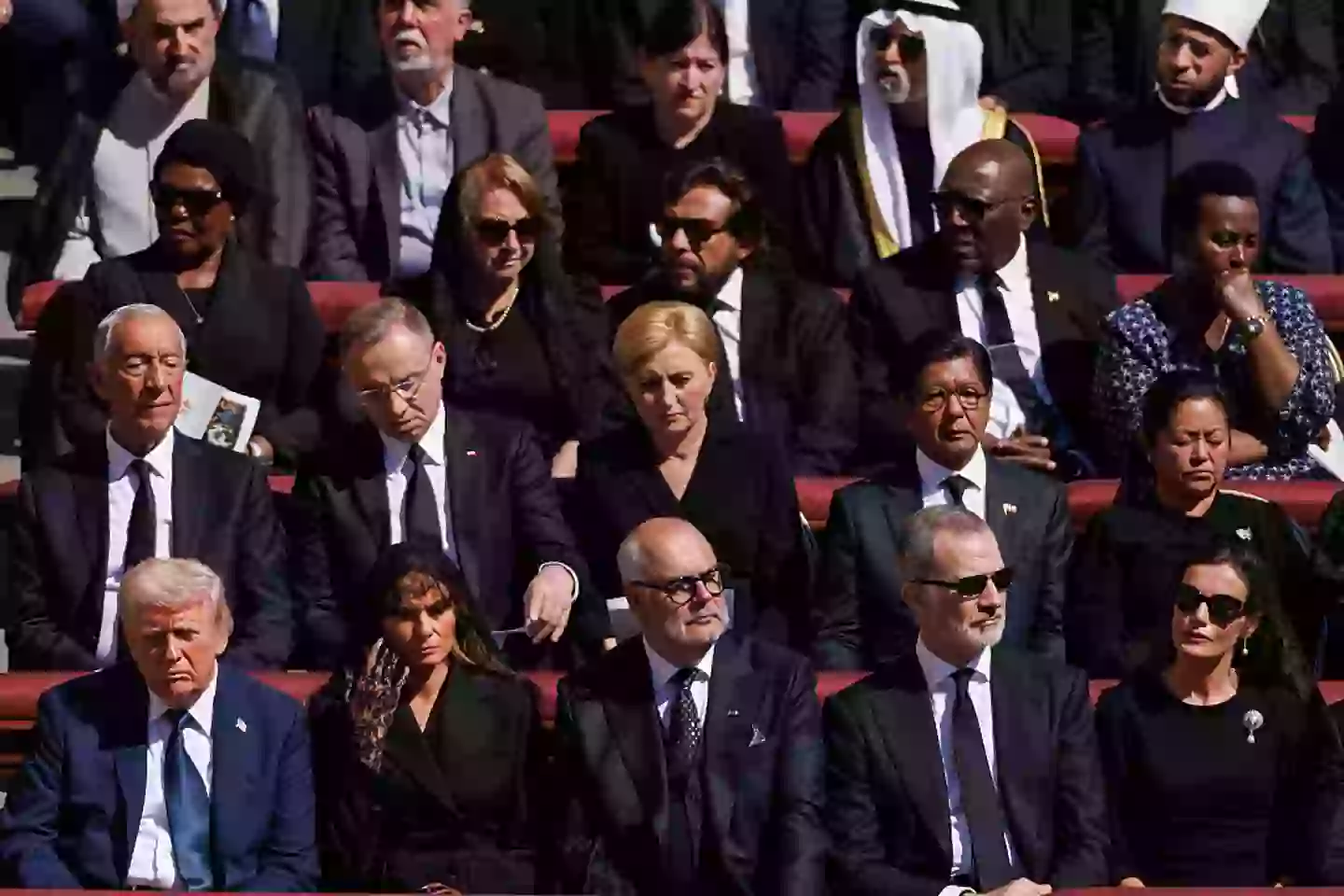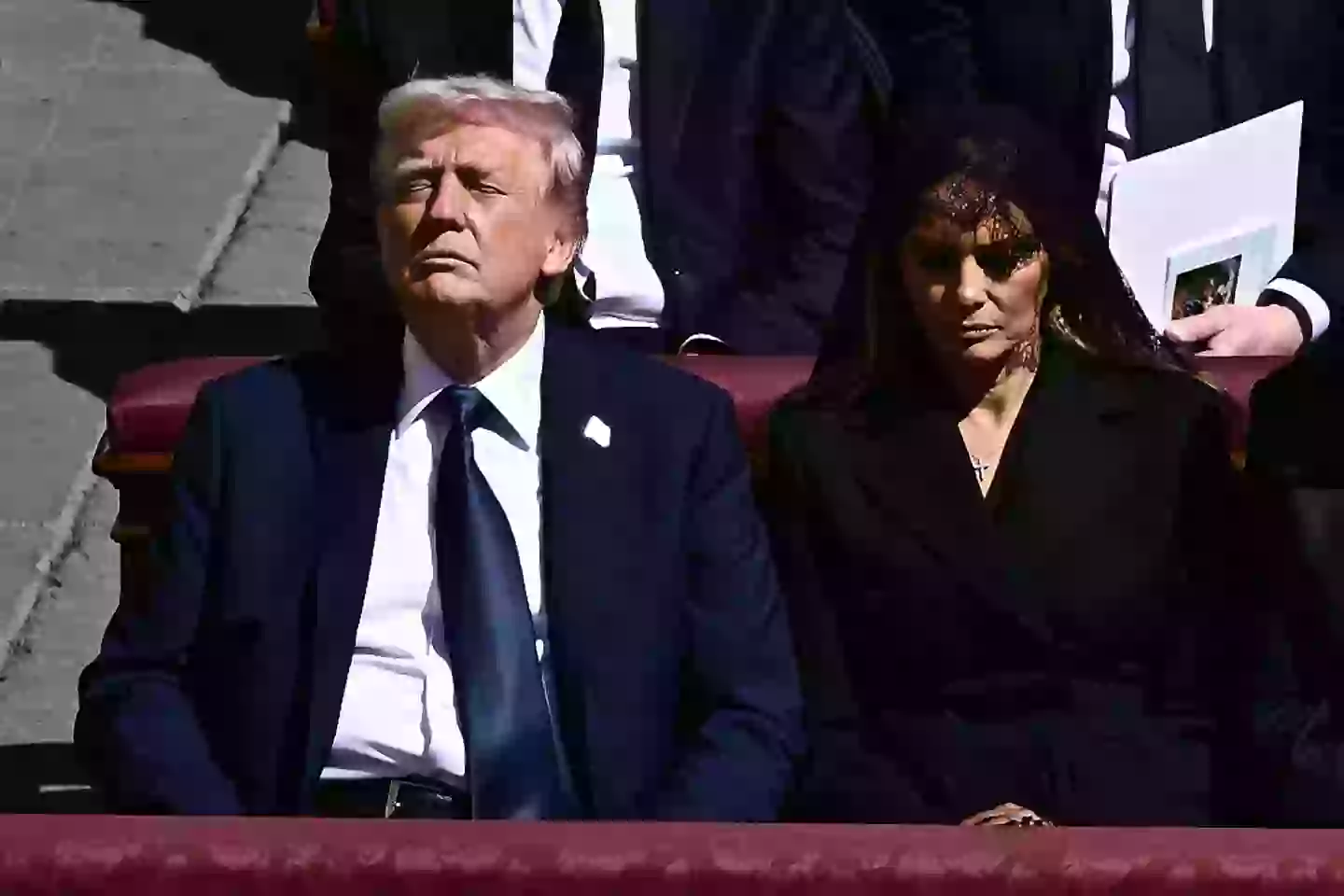A Global Farewell to Pope Francis
On Saturday, April 26, 2025, the world bid farewell to Pope Francis at the Santa Maria Maggiore Basilica in Rome. Following a solemn requiem Mass at St. Peter’s Basilica, more than 200,000 mourners gathered in St. Peter’s Square—royalty, heads of state, faith leaders, and countless pilgrims—to honor the late pontiff, who passed away on Easter Monday at age 88 from complications of a stroke and heart ailment. Among the assembled dignitaries were U.S. President Donald J. Trump and First Lady Melania Trump, Ukraine’s President Volodymyr Zelenskyy, U.K. Prime Minister Keir Starmer, and Prince William of Wales.
In spite of the occasion’s gravity, multiple observers noted several instances in which President Trump’s demeanor and actions appeared at odds with longstanding Catholic funeral protocol. Social media amplified each perceived misstep, with critics calling them “disgraceful” and accusing Trump of putting personal brand before solemn respect. Below, we catalogue and contextualize every controversial moment, exploring both the formal rules of ceremony and the broader significance of presidential comportment on the global stage.

1. The Suit That Stood Out
Funeral Dress Code in Catholic Tradition
For Catholics, the color black has long signified mourning and humility before death. At funerals—especially a papal funeral—the expectation is that clergy and lay participants alike will don predominantly black attire. This visual uniformity underscores collective grief and deference to the deceased’s spiritual authority.
President Trump’s Choice
Instead of a traditional black suit, President Trump arrived in a bright navy ensemble paired with a contrasting blue tie. In so doing, he diverged not only from the host nation’s custom but also from most other world leaders present. Prince William, for example, wore a dark blue suit, a choice some observers likened more to business attire than to funeral attire.
Reactions and Implications
Critics argued that the navy ensemble drew undue attention to Trump rather than to the late pope, leading to widespread social‐media commentary:
“Of course Trump is the only jacka** wearing a blue suit and blue tie to a funeral… such an embarrassment,” one viewer tweeted.
“Donald Trump couldn’t even be respectful and wear a black suit to Pope Francis’ funeral like the rest of world leaders. He always has to stick out,” chimed another.
Defenders counter that funeral dress codes vary by culture and that many faiths—including some Protestant traditions—do not enforce strict all‐black garments. Nevertheless, at a gathering as symbolically charged as a pope’s funeral, most would agree on the importance of visual solemnity, a standard that Trump’s wardrobe choice failed to meet.
2. Stepping onto Holy Ground
The Significance of the Carpet
At the Basilica of Santa Maria Maggiore, a special carpet was laid around and beneath the pope’s casket. According to Vatican ceremony guides, this carpeted area is considered “holy ground,” reserved exclusively for the person of the pontiff. Attendees are instructed to pause at the boundary, pay silent respects, then withdraw without crossing onto the rug itself.
The Infraction
Video footage captured both President Trump and the First Lady unconsciously letting the toes of their shoes encroach upon, and in some frames, fully stepping onto the sacred carpet. While the gesture appeared minor, insiders at the ceremony insist that the rule is well known to diplomats and heads of state—making the breach all the more conspicuous.
Diplomatic Etiquette versus Reality
Crisscrossing a ceremonial boundary may seem a small slip in the flurry of a formal procession. Still, on an occasion meticulously choreographed down to the minute, such a misstep carries symbolic weight. Diplomats and protocol officers invest weeks in ensuring that each gesture and placement at a papal funeral reflects centuries of tradition. By crossing onto the carpet, Trump inadvertently signaled either unfamiliarity with—or disregard for—the Vatican’s ceremonial strictures.
3. Phone Use during Mass
Technology and Reverence
Modern funerals often accommodate discreet phone usage—crucial, for instance, for translation apps or to receive urgent communications. However, using a personal device for casual purposes during a liturgical event, especially in the front row, breaches expectations of solemnity.
Observations of Trump on His Phone
Multiple camera angles later revealed President Trump leaning forward to scroll through his cellphone midway through the service. He could be seen typing, then glancing up—sometimes appearing to mask the device behind his hand.
Broader Context
Given that dozens of other attendees also briefly checked phones for translation or note‐taking, some critics caution against singling out Trump. Yet, as the leader of one of the world’s most influential nations, the president’s behavior at a Papal funeral carries outsized symbolic resonance. In an event where millions were watching, the sight of a head of state engaging with a cellphone risked undermining the ceremony’s gravitas.
4. Brief Naps in the Front Row

Body Language in Ceremonial Settings
Falling asleep at a high‐profile ceremony is a rare and often embarrassing gaffe. Even momentary nods of drowsiness can be read as disrespect—especially when the event honors a religious figure revered for his humility and vigor.
Captured Moments
During the requiem Mass and subsequent rites, broadcast footage caught President Trump with his eyes closed on several occasions. His head dipped slightly forward, and in at least one shot, his mouth hung open mid‐rest.
Weighing Fatigue against Disrespect
While exceptional circumstances—jet lag, a cross‐continent flight schedule, a long morning of engagements—might explain short bouts of fatigue, no such mitigating excuses appeared in the official White House schedule. Public perception hinged, instead, on the optics: a world leader seemingly dozing at the funeral of a widely beloved pontiff.
5. Chewing Gum in the Sanctuary
Eucharistic and Liturgical Norms
Chewing gum is generally prohibited inside Catholic churches during Mass. The act is perceived as distracting and unbefitting the sacredness of the sacramental altar.
Trump’s Unconventional Snack
At one point in the ceremony, President Trump opened a small packet and popped a piece of gum into his mouth. The motion, captured clearly in live feeds, led to immediate social‐media reaction.
Public Reaction
Many viewers deemed the act more flippant than the phone usage or the accidental nap:
“He chucked gum in his mouth during the funeral—just blasphemous!”
“It’s a freaking funeral, nimrod. No gum allowed.”
This incident compounded the broader narrative that Trump treated the occasion less as a spiritual ceremony and more as an opportunity for personal comfort.
6. A Swift Departure
Common Practice for Heads of State
After events of this magnitude, carefully choreographed departure protocols typically allow dignitaries to pay their final respects, greet the host, and then depart in an orderly procession. Papal funerals, in particular, provide moments for private reflection before attendees leave.
Trump’s Early Exit
As soon as the final prayers concluded, President Trump and the First Lady were among the first in their row to rise and move rapidly toward the exit. Video shows a brisk walk—no lingering farewells, no private audience with the camerlengo, no moment of silent reflection in the nave.
Diplomatic Implications
While world leaders often balance packed schedules, the sheer haste of Trump’s departure contrasted starkly with peers who remained to console Vatican officials or to speak quietly with fellow delegations. The impression left on both Vatican insiders and international observers was that the U.S. president saw the funeral more as a photo opportunity than as a solemn duty.
7. Social Media Backlash
Instantaneous Commentary
Within moments of each perceived breach—suit color, carpet crossing, phone use, napping, gum chewing, early departure—social‐media users fired off thousands of posts. Hashtags such as #ProtocolFail and #DisgraceAtTheBasilica trended globally.
Selected Responses
-
“Trump fell asleep at the Pope’s funeral, walked on the rug, refused a dark suit, then left early. Sheesh.”
-
“Of course, he made it all about himself—even at a funeral.”
-
“Media pundits: ‘No one treats a funeral like Donald Trump.’”
The Press’s Take
Major news outlets ran critical op-eds and “top ten” lists of White House faux-pas. Some commentators speculated that Trump’s motivations were explicitly political—to flatter conservative Catholic voters in key swing states—rather than spiritual or diplomatic.
8. The Importance of Presidential Decorum
Why Protocol Matters
Ceremonial protocol serves multiple functions: it demonstrates respect for the host nation’s traditions, reinforces the solemnity of significant events, and conveys the attending dignitary’s understanding of and reverence for the occasion. For a papal funeral, with its global viewership and interfaith resonance, protocol violations risk sending unintended messages about the visitor’s seriousness and sincerity.
A President under the Spotlight
In an era of 24/7 news cycles and ubiquitous smartphone cameras, every gesture by a president is instantly recorded, magnified, and interpreted. Small breaches that might once have gone unnoticed now become viral talking points. For President Trump—whose persona thrives on commanding attention—such moments reinforce critics’ arguments that he prioritizes spectacle over substance.
9. Balancing Personal Style with Global Expectations
The Tension between Individuality and Diplomacy
World leaders often cultivate distinctive personal brands: Winston Churchill with his bowler hat and cigar, John F. Kennedy with his idiosyncratic Cambridge accent, Angela Merkel with her tailored blazers. Yet, at formal global ceremonies, even the most distinctive figures typically subsume personal style to collective ceremony.
Trump’s Signature Boldness
Whether by design or habit, President Trump has long favored bold attire—bright ties, custom-tailored suits—and brash gestures. At political rallies, this approach has galvanized supporters; in diplomatic settings, however, it can clash with expectations of subdued formality.
10. Reflection and Moving Forward
A Teachable Moment for Future Ceremonies
Regardless of partisan loyalties, the episode at Pope Francis’s funeral illustrates the enduring power of ceremonial tradition—and the importance of careful preparation. For heads of state and their protocol teams, this event will likely serve as a case study in how minor oversights can overshadow the intended message of respect.
Shaping Presidential Legacy
In the days following the funeral, analysts debated whether these protocol breaches would leave a lasting stain on President Trump’s diplomatic record. Some argue that the reaction was overblown, driven by social media hyperbole. Others maintain that, in the delicate realm of international relations, precision in ceremony reflects precision in policy and character.
Conclusion
At the funeral of one of the most beloved figures in modern Catholic history, every gesture carried profound symbolic weight. From a bright‐blue suit that broke with tradition, to the accidental crossing onto sacred carpeting, to moments of cellphone scrolling, gum chewing, and even nodding off, President Trump’s actions drew swift and widespread criticism. For a global leader, these seemingly small lapses offered a reminder that protocol is more than formality—it is a language of respect. As the world moves forward, the lessons of that April morning in Rome will resonate for statesmen who must balance personal style with the solemn dignity that such transcendent moments demand.

Adrian Hawthorne is a celebrated author and dedicated archivist who finds inspiration in the hidden stories of the past. Educated at Oxford, he now works at the National Archives, where preserving history fuels his evocative writing. Balancing archival precision with creative storytelling, Adrian founded the Hawthorne Institute of Literary Arts to mentor emerging writers and honor the timeless art of narrative.
